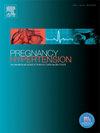Detection of hypertension and blood pressure phenotypes using ambulatory blood pressure monitoring in women with past hypertensive disorders of pregnancies
IF 2.9
4区 医学
Q2 OBSTETRICS & GYNECOLOGY
Pregnancy Hypertension-An International Journal of Womens Cardiovascular Health
Pub Date : 2025-01-20
DOI:10.1016/j.preghy.2025.101193
引用次数: 0
Abstract
Objective
To evaluate the incidence of hypertension and blood pressure (BP) phenotypes using 24-hour ambulatory BP (24hr-ABP) in women with past pregnancy complications who were recruited into a Women’s Heart Clinic (WHC).
Study design
We recruited 156 women aged 30–55 years with past hypertensive disorders of pregnancy (HDP) and/or gestational diabetes (GDM) to a multidisciplinary six-month WHC that provided cardiovascular risk management in Melbourne, Australia. Women were referred for 24 hr-ABP monitoring if clinic BP was ≥130/80 mmHg.
Main outcome measures
Primary outcome was incident hypertension, defined by 24 hr-ABP monitoring as daytime hypertension ≥135/85 mmHg, nocturnal hypertension ≥120/70 mmHg, and/or 24hr-average hypertension ≥130/80 mmHg.
Results
From 156 women, 54 women underwent 24hr-ABP monitoring (mean age 41.3 ± 4.5 years; 3.9 ± 2.6 years post-partum), with 64.8 % HDP and 45.2 % GDM. Incidence of hypertension was 61.1 % [95 % CI 48.2 %–74.0 %]. Higher proportion of women with past HDP had daytime hypertension compared to those with GDM only (57.1 % vs. 26.3 %; p = 0.05) and higher nocturnal mean systolic-BP [116.0 ± 11.2 mmHg vs. 109.6 ± 8.7 mmHg; p = 0.04]. Women with HDP had increased odds of hypertension [adjusted-OR 5.26 95 % CI (1.07–32.76); p = 0.05]. Following management at the WHC, women diagnosed with hypertension had significantly improved BP control (6.1 % at baseline vs. 75.8 % at six-month follow-up; p < 0.001).
Conclusion
Women with past HDP had five-fold increased incidence of hypertension, with higher daytime hypertension and nocturnal systolic-BP, compared to women with GDM. After attending WHC, BP control significantly improved. Our findings suggest routine postpartum follow-up with 24hr-ABP monitoring, through a WHC, may be useful in early detection and management of hypertension in these women.

妊娠期有高血压病史的妇女使用动态血压监测检测高血压和血压表型
目的:利用24小时动态血压(24hr-ABP)评估在妇女心脏诊所(WHC)招募的有妊娠并发症的妇女中高血压和血压(BP)表型的发生率。研究设计:我们招募了156名年龄在30-55岁之间,既往患有妊娠期高血压疾病(HDP)和/或妊娠期糖尿病(GDM)的女性,在澳大利亚墨尔本进行为期6个月的多学科WHC,提供心血管风险管理。如果女性临床血压≥130/80 mmHg,则进行24小时abp监测。主要结局指标:主要结局为偶发性高血压,24小时abp监测定义为白天高血压≥135/85 mmHg,夜间高血压≥120/70 mmHg,和/或24小时平均高血压≥130/80 mmHg。结果:156名妇女中,54名妇女接受了24小时abp监测(平均年龄41.3±4.5岁;产后3.9±2.6年),HDP占64.8%,GDM占45.2%。高血压的发生率为61.1% [95% CI 48.2% - 74.0%]。与仅患有GDM的女性相比,既往患有HDP的女性白天高血压的比例更高(57.1% vs 26.3%;p = 0.05)和较高的夜间平均收缩压[116.0±11.2 mmHg vs. 109.6±8.7 mmHg;p = 0.04]。患有HDP的女性患高血压的几率增加[调整比值比5.26 95% CI (1.07-32.76);p = 0.05]。在WHC接受治疗后,诊断为高血压的女性血压控制显著改善(基线时为6.1%,六个月随访时为75.8%;p结论:与GDM患者相比,既往HDP患者的高血压发病率增加了5倍,白天高血压和夜间收缩压升高。参加WHC后,血压控制明显改善。我们的研究结果表明,通过WHC进行24小时abp监测的常规产后随访可能有助于这些妇女高血压的早期发现和管理。
本文章由计算机程序翻译,如有差异,请以英文原文为准。
求助全文
约1分钟内获得全文
求助全文
来源期刊

Pregnancy Hypertension-An International Journal of Womens Cardiovascular Health
OBSTETRICS & GYNECOLOGYPERIPHERAL VASCULAR-PERIPHERAL VASCULAR DISEASE
CiteScore
4.90
自引率
0.00%
发文量
127
期刊介绍:
Pregnancy Hypertension: An International Journal of Women''s Cardiovascular Health aims to stimulate research in the field of hypertension in pregnancy, disseminate the useful results of such research, and advance education in the field.
We publish articles pertaining to human and animal blood pressure during gestation, hypertension during gestation including physiology of circulatory control, pathophysiology, methodology, therapy or any other material relevant to the relationship between elevated blood pressure and pregnancy. The subtitle reflects the wider aspects of studying hypertension in pregnancy thus we also publish articles on in utero programming, nutrition, long term effects of hypertension in pregnancy on cardiovascular health and other research that helps our understanding of the etiology or consequences of hypertension in pregnancy. Case reports are not published unless of exceptional/outstanding importance to the field.
 求助内容:
求助内容: 应助结果提醒方式:
应助结果提醒方式:


